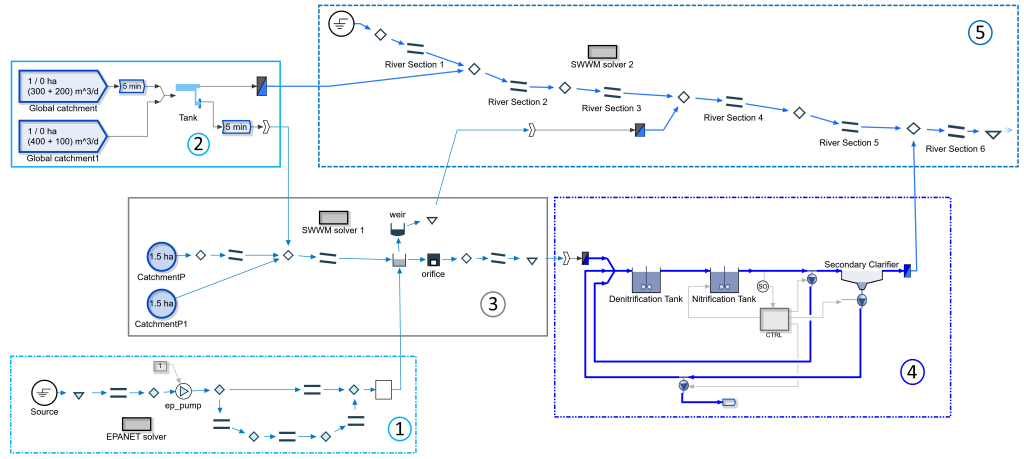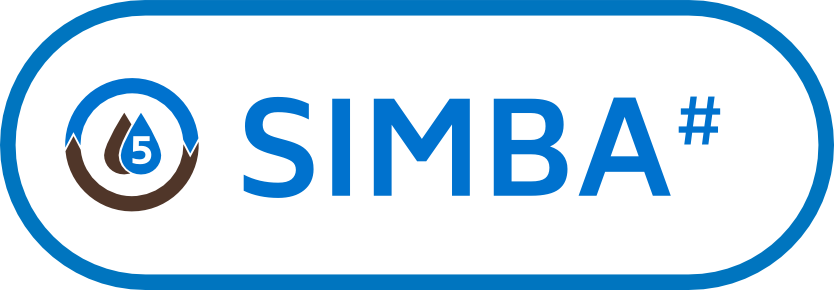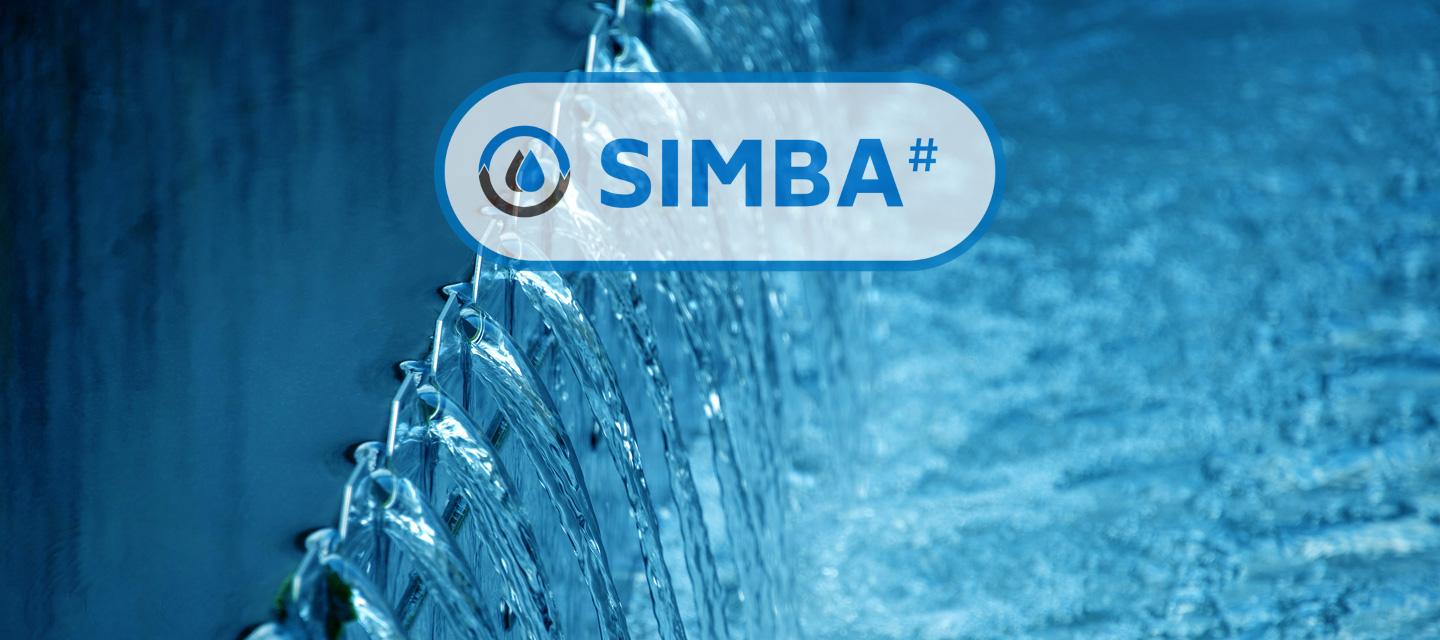SIMBA# 5.0 Release
SIMBA#, the simulation system for innovative model-based solution concepts for manifold applications in the water, wastewater and biogas areas has reached a new milestone!
The new version SIMBA# 5.0 raises the modelling of wastewater treatment plants, sewer networks, rivers and pressure pipe systems to a new level. The release notes list the most important innovations. In particular, the immission-based consideration of water quality with discharges from sewer networks and wastewater treatment plants is now considerably improved. For this purpose, SIMBA# provides a "multi-solver" simulation environment with which several sewer networks (hydrodynamical modelling), river sections, pressure pipe networks and treatment plants can be simulated in parallel, each of them with a dedicated solution algorithm (see figure). The project representation is now alternatively also possible in a geographically referenced view.
In detail, the new SIMBA# 5.0 includes, among others, the following developments:
(You may find a video (only in German language) on our YouTube channel: https://www.youtube.com/watch?v=zMnGBPZQixQ)
- GIS-based modelling: georeferenced representation of sewer networks, rivers, drinking water networks, additionally representation of GIS shape files and bitmaps.
- Extended catchment block: definition of area partitions of catchments with different pollution and runoff characteristics, implementation of AFS63 pollution according to the new German DWA-A-102-2 guideline, GIS-based network representation, import of area information (impervious surfaces) from Copernicus satellite data.
- Digital Elevation Model (DEM): representation and usage of DEM information for modelling fluxes in supply and disposal infrastructures (e.g. sewer networks, drinking water networks), use in blocks for network modelling.
- Hydrodynamic modelling of sewer networks and rivers: extension of different mass transport approaches Continuously Stirred Tank Reactor and Lagrangian approaches), modelling with arbitrary biochemical transformation processes in sewer networks and water bodies, provision of a new hydrodynamic special solver, new block library.
- Pressure pipe networks library: modelling of drinking water and sewer networks and industrial water systems, provision of a new solver for algebraic calculation of pressures and flows.
- Multi-phase reactors: modelling the interactions between liquid, gas and biofilm phases. This allows the modelling of a whole range of new reactor types and processes. The multi-phase approach is particularly suitable for developing models for industrial wastewater treatment.
- Sewer network real time control: extension of the modules for model-based predictive control, application of any external and internal models, provision of various local and global optimisation algorithms.
- Significantly enhanced documentation (manuals, videos) and user interface.
- Now, the previously separate packages SIMBA#water and SIMBA#biogas have been merged into one unique package SIMBA# 5.0 in order to allow all users to work on solutions in the water, wastewater and biogas areas.

Example of an integrated model in SIMBA# 5.0 with parallel simulation of subsystems with respective special solvers (Pressure Pipe Network (1), Catchment (2), Sewer Network (3), WWTP (4), River (5))
Helpful explanatory videos on how to use SIMBA# can now also be found on our YouTube Channel.
The simulation system SIMBA# is a versatile software for modelling and dynamic simulation in wastewater technology. It integrates activated sludge models, aeration systems, sludge digestion, sewer networks, receiving waters and any kind of automation solutions.

Since its first beginnings in 1994, the simulation tool SIMBA has been accompanying research and application in the field of modelling and simulation of wastewater treatment plants, sewer networks, river water quality and agricultural biogas plants worldwide for 25 years now. In the first years SIMBA was a toolbox for the software tool MATLAB/Simulink, which is widely used in science. Since 2013, SIMBA has been a technically independent development and is also ideally suited for engineering applications.
With the ever-increasing demands in the field of planning and operational management of wastewater treatment plants, SIMBA aims to support classical design methods in these areas with the tool simulation. For the field of wastewater treatment plants this is expressed by a close interlocking of the design specification DWA A131 with the mathematical activated sludge models ASM3 (Activated Sludge Model No. 3) and ASM3biop as well as the modules available in SIMBA for individual process steps (denitrification, nitrification, secondary treatment, etc.). In the current version 4.2, the interaction of process engineering with the mechanical equipment (e.g. the aeration system) and planned automation options is also mapped in detail, thus enabling optimization.
It allowed the integrated simulation of wastewater treatment processes with state-of-the-art activated sludge models or own model developments, the mechanical equipment of sludge treatment plants and all conceivable control options. It also allows an integrated simulation of the wastewater treatment plant with the sewer networks and flowing waters for an immission-based analysis of urban drainage systems. SIMBA is also open and flexible outside of urban drainage systems and can be used for many other processes, e.g. for the simulation of biogas plants, new types of sanitary systems of service and drinking water systems.
SIMBA can be used to implement a wide range of applications in engineering practice and in research and teaching. These include, for example, the design of plants, processes and control concepts, the optimization of process design and the development of concepts for the energy management of wastewater treatment plants. A new feature is the development of model based operation management concepts (observer, MBPC) which can also be used in an online version together with the open-source development ifakFAST for the operation of real plants.
SIMBA# is programmed in C# and it runs under the Windows 7, 8 and 10 operating systems.
Fields of application
With SIMBA#, tasks in engineering practice and in research and teaching can be processed:
- Design of wastewater treatment plants including numerous process options including control
- Optimisation of process design and operational management of existing wastewater treatment plants
- Analysis of runoff events in urban areas
- Development and testing of strategies for sewer network management or sewer network control
- Investigation of the interaction of wastewater discharge, wastewater treatment, sludge treatment and water quality
- Analysis of process water management, sludge treatment and energy consumption
- Planning the deployment of "Digital Twins”
- Virtual commissioning of automation solutions
Model libraries
The construction of simulation models is based on the graphic interconnection of model blocks, each of which represents a process component (e.g. sewer section, primary treatment, aeration tank). A central block library forms the starting point for each simulation project. Here you will find blocks to define, distribute and merge wastewater and sludge flows. Furthermore, there are sedimentation tanks and different reactor models (stirred tank reactor, batch reactor) to represent any chemical and biological purification processes:
- Activated sludge processes of wastewater treatment (ASM1, ASM3, ASM3biop, ...)
- Biofilm processes of waste water treatment (MBBR, FBBR, MABR, TF, Granula, )
- Anaerobic degradation processes (digestion), sludge treatment
- 4. cleaning stage with PAC
- Process water treatment (Anammox)
- Wastewater transport, retention and material conversion in sewer networks (hydrological and/or SWMM)
- Water transport and water quality in natural flowing waters
- Control functions including MBPC
- Aeration systems
- Pressure pipelines and pumps
- Drinking water analyses
- Waste water treatment plants
-
For the simulation of waste water treatment plants, various combinations of transport and reactor models and activated sludge models are available. Transport and reactor models are understood here, for example, as model blocks for the description of an activated sludge mixture in tanks with intensive mixing and/or aeration by surface aerators and pressure aeration system as well as pre- and final clarification tanks. Basin cascades and batch reactors are also available. Independent of these reactor models, the user can choose which so-called activated sludge model he wants to work with. Such an activated sludge model defines a number of substance groups of wastewater constituents and microorganisms as well as a number of chemical and biological processes which are considered important for the respective processes. For the description of the degradation of organic pollutants (COD) and the removal of nitrogen (nitrification/denitrification), for example, the standard models ASM1 (Activated Sludge Model No.1) and ASM3 of the IWA are available. For planning purposes, the ASM3h and ASM3bioph are available in versions from the HSG (researcher group) that are compatible with DWA A131 2016.
Models can be freely edited or modified with an easy to use editor in Petersen-Matrix Notation. Standard models (ASM1, ASM3, ADM1, RWQM1, ...) are already included in SIMBA.
The following activated sludge models are implemented in SIMBA as standard:
- ASM1h – standard model of IWA with established modifications to improve applicability, parameters according to HSG Simulation
- ASM3h – Version of the ASM3 of the IWA with parameterization according to proposals of HSG
- ASM3bioph – IWA's ASM3 with an EAWAG extension for biological P-elimination
- ASM_inCTRL – Extended model (COD, multi-step nitrification/denitrification, bioP) provided by the experts of inCTRL
- ASM_XL_lag – Extended model (COD, multi-stage nitrification/denitrification, anammox) as a project result of the NoNitriNox project (BMBF)
Users have the possibility to design model blocks based on their own activated sludge models.
Model blocks for primary and secondary clarification
For the illustration of sedimentation processes in the pre- and post-treatment a range of different complex models is available, e.g:
- 3-layer secondary settling model with variable sludge bed compatible with DWA A131 2016
- Simple primary clarification model according to Otterpohl/Freund with predetermined COD elimination as a function of the residence time
- Ideal settling tank (ideal solid/liquid separation, no storage tank)
- Ideal sedimentation tank with storage tank (preset solid/liquid separation and simple storage tank)
Models of aeration systems
Since version 2 SIMBA contains detailed models of aeration systems. The model library contains components for the description of blowers and blower control, piping with typical internals, control valves (conventional and new developments) and diffusers (devices for the fine-bubble entry of air into aeration tanks) which can be interconnected with each other or in connection with a process engineering model of a wastewater treatment plant. Of course, the function of the automation technology can also be taken into account down to the last detail.
With this extension
- Aeration systems are made more energy efficient
- Frequent planning errors, which lead to unfavourable operating behaviour, are avoided
- In the future, increasing requirements for strong load fluctuations during extreme rain events will be better met
- Making energy procurement more flexible (energy management, participation in the energy market)
- Planning analysis of how sewage treatment plants react more intelligently (Industry 4.0 concepts)
Pressure profile along an air supply pipe:
- Sewer systems
-
Hydrological and hydrodynamic modelling approaches
SIMBA# offers high flexibility for the selection of modelling approaches for sewer systems:
Hydrodynamic
• Complete solution of Saint-Venant-equations
• Seemless integration and extension of computational kernel of SWMM5 (cf. www.epa.gov)Hydrologic
• Simplified, conceptual modelling
• Transport pipes within the sewer network
• Ancillary structures according to DWA-A 128
• Pollutant load calculations and long-term simulationArbitrary combination of both modelling approaches
Within SIMBA#, it is also possible, to model parts of a drainage network using a hydrodynamic approach (e.g. flat main collector sewers), whilst other parts of the same network (e.g. upstream subcatchments) can be modelled using a faster hydrologic modelling approach. This feature of SIMBA# allows you to adjust the complexity of a sewer network model to the specific needs of each particular project.
Each of these modelling approaches allows:
- Uniform and non-uniform spatial distribution of rainfall
- Arbitrary biochemical transformation processes within the network (modelling of the sewer as a physical, biological and chemical reactor)
- Simple and complex open and closed loop control concepts
- Analysis of RTC potential according to the German guideline DWA-M 180
Furthermore, SIMBA# allows the seamless integration of sewer system simulation with models of the other subsystems (WWTP, sludge treatment, river water systems).
User-friendly input and output, animation
- User input and output, for example when defining the sewer network, are graphically supported
- Freely configurable evaluation routines allow fast and easy evalutation providing textual and graphical information: Summary information (rainfall; discharge and overflow volumes and pollutant loads, storage utilisation), discharge frequencies and durations
- Anaerobic processes
-
Anaerobic processes
The modelling of anaerobic processes (anaerobic wastewater treatment, sewage sludge digestion) increasingly gains in its importance due to continuous demands for the optimum energy operation of plants. Further incentives for the application of digestion models are given by the current developments within the biogas sector. The anearobic sublibrary provides options for the modelling of plants for anaerobic sludge digestion, anaerobic wastewater treatment and anaerobic fermentation of organic loads.
This dedicated library contains:
- Various anaerobic models (Siegrist, simplified approach)
- Model blocks for primary clarification with sludge removal
- Model blocks for mechanic thickening as well as dewatering of sludge
- Anaerobic reactor blocks (surcharge reactor, storage) with gaseous phase
- Interface models for linking with activated sludge models
- Integrated modelling of wastewater treatment and sludge treatment
Anaerobic models allow the prognosis of:
- COD, TS degradation
- Gas production, gas synthesis (carbon dioxide, methane, hydrogen)
- Nitrogen release
- Organic acids and pH
- Receiving waters
-
River water quality simulation
SIMBA# allows the simulation of flows and water quality in receiving water bodies. Any arbitrary biochemical transformations can be modelled. A seamless integration with sewer systems and wastewater treatment models and also with control algorithms is possible.
Flow calculation
- Hydrologic flow modelling
- Hydrodynamic flow modelling
Quality models
- Can be specified and modified freely by the user
- Predefined models available (e.g. SWQM, RWQM1, Lijklema)
Applications
- River water quality simulation
- Analysis of wastewater discharges from sewer system and WWTP
- Assessment of urban discharges on river water quality according to the new guideline document of the German federal state of Hesse
- Integrated real time control
- Sequential and parallel integrated simulation
Modelling approach according to Lagrange
An additional module contains the Lagrange modelling approach for pollutant transport, which allows transport modelling without the introduction of errors by numerical dispersion. The Lagrange modelling approach is based on the core principle of “water parcels“ moving along the river. Dedicated routines for the joining and splitting of these conceptual water parcels facilitate speed-optimised simulation.
Evaluation according to UPM Manual and BWK-M7
New evaluation routines for the analysis of results of river water quality simulation
- Freely configurable textual and graphical output
- Plots of longitudinal profiles
- Time-space-diagrams: All the information at one glance!
- Flows and water quality
- Frequency-duration-based threshold values for oxygen, ammonium and ammonia according to the British Urban Pollution Management (UPM) Manual and to the German BWK-M7 document
Time-space-diagram: Dissolved Oxygen concentration in the receiving water body: The impacts of the combined sewer overflow discharge at location x=3000 m at time t=3 d on the oxygen concentration in the river can clearly be seen:
Evaluation of CSO discharges on oxygen concentrations in the river according to the criteria of the “Urban Pollution Management Manual”, which are based on return frequency and duration of exposure:
- Water-Energy-Food Nexus
-
The new NEXUS library of Simba#4 allows to set up models for integrated water resource management (including rainwater harvesting and greywater treatment and reuse), managing availability and demand of water resources. Furthermore, also models considering the interactions and synergies between different infrastructure systems (such as water, energy, food, solid waste) can be set up. Modelling results can be visualized also by Sankey diagrams, thus facilitating stakeholder discussions and decisions. Also the generation of so-called “Shit Flow Diagrams” with the new modules of Simba#4 is easily possible.
Simple example: Drinking water supply of two city districts, integration with electricity demand:
Nexus City: Resource fluxes of the infrastructure sectors Water, Wastewater, Energy, Waste and Food of an example city:




